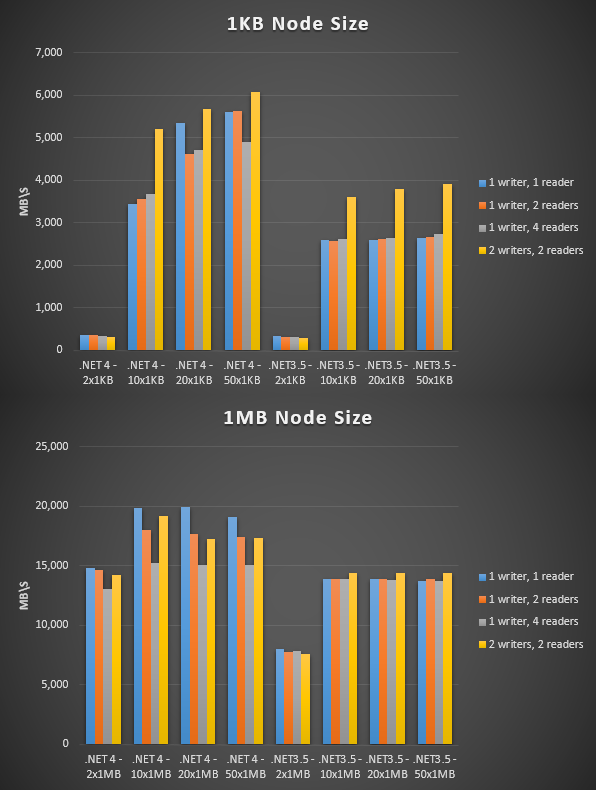C# shared memory classes for sharing data between processes (Array, Buffer and Circular Buffer)
The SharedMemory class library provides a set of C# classes that utilise memory mapped files for fast low-level inter-process communication (IPC) - specifically for sharing data between processes.
The library uses the .NET 4 MemoryMappedFile class in .NET 4.0+, and implements its own wrapper class for .NET 3.5.
- SharedMemory.SharedBuffer - an abstract base class that wraps a memory mapped file, exposing the read/write operations and implementing a small header to allow clients to open the shared buffer without knowing the size beforehand.
- SharedMemory.BufferWithLocks - an abstract class that extends SharedMemory.SharedBuffer to provide simple read/write locking support through the use of EventWaitHandles.
- SharedMemory.SharedArray - a simple generic array implementation utilising a shared memory buffer. Inherits from SharedMemory.BufferWithLocks to provide support for thread synchronisation.
- SharedMemory.BufferReadWrite - provides read/write access to a shared memory buffer, with various overloads to support reading and writing structures, copying to and from IntPtr and so on. Inherits from SharedMemory.BufferWithLocks to provide support for thread synchronisation.
- SharedMemory.CircularBuffer - lock-free FIFO circular buffer implementation (aka ring buffer). Supporting 2 or more nodes, this implementation supports multiple readers and writers. The lock-free approach is implemented using Interlocked.Exchange and EventWaitHandles.
The output from the of the following examples is:
SharedMemory.SharedArray:
123
456
SharedMemory.CircularBuffer:
123
456
SharedMemory.BufferReadWrite:
123
456
SharedMemory.SharedArray
Console.WriteLine("SharedMemory.SharedArray:");
using (var producer = new SharedMemory.SharedArray<int>("MySharedArray", 10))
using (var consumer = new SharedMemory.SharedArray<int>("MySharedArray"))
{
producer[0] = 123;
producer[producer.Length - 1] = 456;
Console.WriteLine(consumer[0]);
Console.WriteLine(consumer[consumer.Length - 1]);
}
SharedMemory.CircularBuffer
Console.WriteLine("SharedMemory.CircularBuffer:");
using (var producer = new SharedMemory.CircularBuffer(name: "MySharedMemory", nodeCount: 3, nodeBufferSize: 4))
using (var consumer = new SharedMemory.CircularBuffer(name: "MySharedMemory"))
{
// nodeCount must be one larger than the number
// of writes that must fit in the buffer at any one time
producer.Write<int>(new int[] { 123 });
producer.Write<int>(new int[] { 456 });
int[] data = new int[1];
consumer.Read<int>(data);
Console.WriteLine(data[0]);
consumer.Read<int>(data);
Console.WriteLine(data[0]);
}
SharedMemory.BufferReadWrite
Console.WriteLine("SharedMemory.BufferReadWrite:");
using (var producer = new SharedMemory.BufferReadWrite(name: "MySharedBuffer", bufferSize: 1024))
using (var consumer = new SharedMemory.BufferReadWrite(name: "MySharedBuffer"))
{
int data = 123;
producer.Write<int>(ref data);
data = 456;
producer.Write<int>(ref data, 1000);
int readData;
consumer.Read<int>(out readData);
Console.WriteLine(readData);
consumer.Read<int>(out readData, 1000);
Console.WriteLine(readData);
}
The maximum bandwidth achieved was approximately 20GB/s, using 20 nodes of 1MB each with 1 reader and 1 writer. The .NET 3.5 implementation is markedly slower (~14GB/s), I believe this is due to framework level performance improvements.
The following chart shows the bandwidth achieved in MB/s using a variety of circular buffer configurations, ranging from 2 nodes to 50 nodes with a varying number of readers/writers, comparing a 1KB vs 1MB node buffer size on .NET 3.5 and .NET 4.
All results are from a machine running Windows 10 64-bit, Intel Core i7-3770K @ 3.50GHz, 16GB DDR3@1200MHz on an ASUS P8Z77-V motherboard. The data transferred was selected randomly from an array of 256 buffers that had been populated with random bytes.
